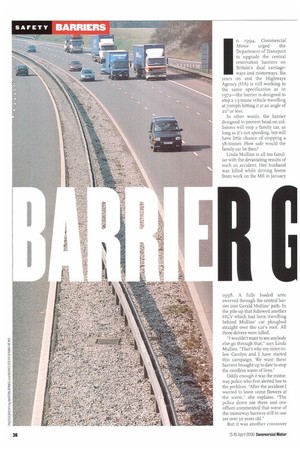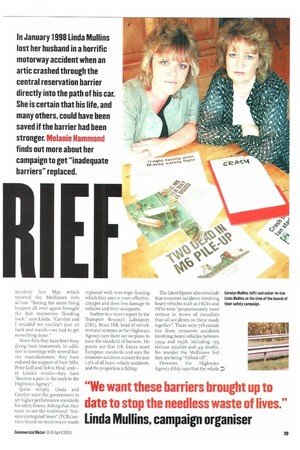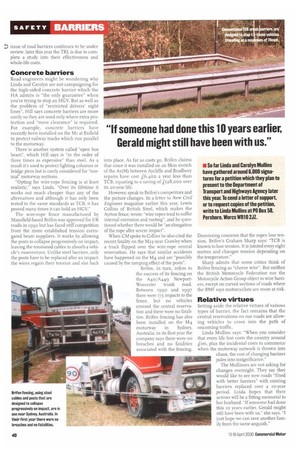n 1994, Commercial Motor urged the Department of Transport to
Page 40

Page 41

Page 42

If you've noticed an error in this article please click here to report it so we can fix it.
upgrade the central reservation barriers on Britain's dual carriageways and motorways. Six years on and the Highways Agency (HA) is still working to the same specification as in 1972—the barrier is designed to stop a 1.5-tonne vehicle travelling at 70mph hitting it at an angle of 200 or less.
In other words, the barrier designed to prevent head-on collisions will stop a family car, as long as it's not speeding, but will have little chance of stopping a 38-tonner. How safe would the family car be then?
Linda Mullins is all too familiar with the devastating results of such an accident. Her husband was killed while driving home from work on the MG in January 1998. A fully loaded attic swerved through the central barrier into Gerald Mullins' path. In the pile-up that followed another HGV which had been travelling behind Mullins' car ploughed straight over the car's roof. All three drivers were killed.
"I wouldn't want to see anybody else go through that," says Linda Mullins. "That's why my sister-inlaw Carolyn and I have started this campaign. We want these barriers brought up to date to stop the needless waste of lives."
Oddly enough it was the motorway police who first alerted her to the problem. "After the accident I wanted to leave some flowers at the scene," she explains. "The police drove me there and one officer commented that some of the motorway barriers still in use are over 30 years old."
But it was another crossover
accident last May which spurred the Mullinses into action. "Seeing the same thing happen all over again brought the bad memories flooding back," says Linda. "Carolyn and I decided we couldn't just sit back and watch—we had to get something done."
Since then they have been busy doing their homework. In addition to meetings with several barrier manufacturers, they have enlisted the support of their MPs, Peter Luff and Sylvia Heal, and— in Linda's words—they have "become a pain in the neck to the Highways Agency".
Quite simply, Linda and Carolyn want the government to set higher performance standards for safety fences. Failing that, they want to see the traditional "tension corrugated beam" (TCB) barriers found on most major roads
replaced with wire-rope fencing which they says is more effective, cheaper and does less damage to vehicles and their occupants.
Further to a recent report by the Transport Research Laboratory (TRL), Brian Hill, head of vehicle restraint systems at the Highways Agency, says there are no plans to raise the standard of barriers. He points out that UK fences meet European standards and says the crossover accidents account for just 1.3% of all heavy vehicle accidents, and the proportion is falling. The latest figures also conclude Carolyn Mullins (left) and sister-in-law that crossover accidents involving Linda Mullins at the time of the launch of heavy vehicles such as HGVs and their safety campaign.
PSVs were "proportionately more serious in terms of casualties than all accidents on these roads together". There were 718 casualties from crossover accidents involving heavy vehicles between 1994 and 1998, including 159 serious injuries and 49 deaths. No wonder the Mullinses Feel they are being "fobbed off".
However, the Highways Agency (HA) says that the whole issue of road barriers continues to be under review: later this year the TRL is due to complete a study into their effectiveness and whole-life costs.
Concrete barriers
Road engineers might be wondering why Linda and Carolyn are not campaigning for the high-sided concrete barrier which the HA admits is the only guarantee" when you're trying to stop an HGV But as well as the problem of "restricted drivers' sight lines", Hill says concrete barriers are more costly so they are used only where extra protection and "more clearance" is required. For example, concrete barriers have recently been installed on the MI at Enfield to protect railway tracks which run parallel to the motorway.
There is another system called "open box beam", which Hill says is "in the order of three times as expensive" than steel. As a result it's used to protect lighting columns or bridge piers but is rarely considered for "normal" motorway sections.
"Opting for wire-rope fencing is at least realistic," says Linda. "Over its lifetime it works out much cheaper than any of the alternatives and although it has only been tested to the same standards as TCB, it has proved many times it can hold an HGV."
The wire-rope fence manufactured by Mansfield-based Brifen was approved for UK roads in 1992 but has faced stiff competition from the more established tension corrugated beam suppliers. It works by allowing the posts to collapse progressively on impact, leaving the tensioned cables to absorb a vehicle's momentum. Unlike steel barriers, only the posts have to be replaced after an impact: the wires regain their tension and slot back
into place. As far as costs go, Brifen claims that since it was installed on an 8km stretch of the AT(M) between Aycliffe and Bradbury repairs have cost f6,400 a year less than TCB, equating to a saving of L128,000 over its 20-year life.
However, speak to Brifen's competitors and the picture changes. In a letter to New Civil Engineer magazine earlier this year, Lewis Collins of British Steel, which makes the Ayrton fence, wrote: "wire ropes tend to suffer internal corrosion and rusting", and he questioned whether there would be "an elongation of the rope after severe impact".
When CM spoke to Collins he also cited the recent fatality on the M23 near Crawley when a truck flipped over the wire-rope central reservation. He says that similar accidents have happened on the M4 and are "possibly caused by the ramping effect of the posts".
Brifen, in turn, refers to the success of its fencing on the A40/A449 NewportWorcester trunk road. Between 1990 and 1997 there were r73 impacts to the fence, but no vehicles crossed the central reservation and there were no fatalities. Brifen fencing has also been installed on the M4 motorway in Sydney, Australia: in its first year the company says there were no breaches and no fatalities associated with the fencing.
Dismissing concerns that the ropes lose tension, Brifen's Graham Sharp says: "TCB is known to lose tension. It is jointed every eight metres and changes tension depending on the temperature."
Sharp admits that some critics think of Brifen fencing as "cheese wire". But neither the British Motorcycle Federation nor the Motorcycle Action Group object to wire barriers, except on curved sections of roads where the BM F says motorcyclists are more at risk.
Relative virtues
Setting aside the relative virtues of various types of barrier, the fact remains that the central reservations on our roads are allowing vehicles to cross into the path of oncoming traffic.
Linda Mullins says: "When you consider that every life lost costs the country around plus the incidental costs to commerce when the motorway network is thrown into chaos, the cost of changing barriers pales into insignificance."
The Mullinses are not asking for changes overnight. They say they would like to see new roads "fitted with better barriers" with existing barriers replaced over a io-year period. Linda hopes that their actions will be a fitting memorial to her husband. 'If someone had done this io years earlier, Gerald might still have been with us," she says. "I just hope we can save another family from the same anguish."












































































































